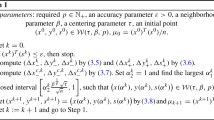Summary
For a linear-programming-problem Max {p′x | Ax ≤ b, x ≥ 0} the so called dual problem is defined as Min {b′ y | y′ A ≥ p, y≥ 0}. The two problems are linked by the following: “Existence Theorem: If both problems have feasible solutions, then both have optimal solutions”; and the “Duality Theorem: If one of the problems has an optimal solution, then both have optimal solutions with equal optimal values”.
In this paper we show that all the different generalisations of these theorems to convex, nonlinear programming problems are special cases of two general theorems, which use the means of the theory of conjugate functions as set forth byFenchel.
For easy understanding we develop the necessary properties of conjugate functions and give proofs of these two general theorems, of which the duality theorem has not been proved before. In the second part we specialise these theorems to some non-linear programming problems and obtain all the different duality theorems ofDennis, Dorn, Hanson, Huard, Wolfe as special cases of these general theorems.
Résumé
On dit que les problèmes de programmation linéaire Max {p′x | Ax ≤ b, x ≧ 0} et Min {b′y | y′ A ≥ p, y ≥ 0} sont duals. Les deux problèmes sont liés par les théorèmes suivants: Théorème d'existence: «Si les deux problèmes ont des solutions possibles, alors ils ont tout deux des solutions optimales.» Théorème de dualité: «Si un problème a une solution optimale, alors les deux ont des solutions optimales de mêmes valeurs.» Dans ce travail nous montrons que toutes les differentes généralisations de ces théorèmes aux problèmes de programmations convexes non linéaires sont des cas particuliers de deux théorèmes généraux qui utilisent les méthodes de la theorie des fonctions conjuguées comme les poseFenchel.
Pour une compréhension plus facile nous développons les propriétés nécessaires des fonctions conjuguées et nous donnons des preuves de ces deux théorèmes généraux dont le théorème de dualité n'a pas été démontré précédemment. Dans la deuxième partie nous particularisons ces théorèmes à quelques problèmes de programmation non linéaire et nous obtenons tous les différents théorèmes de dualité deDennis, Dorn, Hanson, Huard, Wolfe, en tant que cas particulier de ces deux théorèmes généraux.
Similar content being viewed by others
Literaturverzeichnis
Cottle, R. W.: “Symmetric Dual Quadratic Programs”, in “Recent Advances in Mathematical Programming”. McGraw-Hill, New York 1963.
Dennis, J. B.: “Mathematical Programming and Electrical Networks”. Technology Press of the Massachusetts Institute of Technology and John Wiley and Sons, Inc., New York 1959.
Dorn, W. S.: [1] “Duality and Shadow Prices in Non-Linear Programming”. IBM Research Memo. RC 192 (1959).
Dorn, W. S.: [2] “A Duality Theorem for Convex Programs”. IBM Journal, Vol. IV (1960).
Dorn, W. S.: [3] “Duality in Quadratic Programming”. Quarterly of Applied Mathematics, Vol. XVIII (1960).
Dorn, W. S.: [4] “Non-Linear Programming”. IBM Research Memo. RC 266 (1960) and “Management Science” Vol. IX (1963).
Eisenberg, E.: “Duality in homogeneous Programming”. Proc. Amer. Math. Soc. Vol. XII (1961).
Fenchel, W.: “Convex Cones, Sets and Functions”. Lecture Notes, Department of Mathematics, Princeton, University 1953.
Goldman, A. J., andA. W. Tucker: “Theory of Linear Programming”, inKuhn-Tucker [2].
Hanson, M. A.: “A Duality Theorem in Non-Linear Programming with Non-Linear Constraints”. Australian Journal of Statistics, Vol. III (1961).
Huard, P.: [1] “Conditions deKuhn etTucker — Programme Dual — Couts Marginaux”. Groupe de Travail Mathématique de Programmes Economiques, AFCALTI-SOFRO, Séance du 30. 1. 1961 et du 13. 2. 1961.
Huard, P.: [2] “Dual Program”. IBM Journal of Research, Vol. VI (1962).
Huard, P.: [3] “Dual Programs”, in “Recent Advances in Mathematical Programming”. McGraw-Hill, New York 1963.
Karlin, S.: “Mathematical Methods and Theory in Games, Programming, and Economics”. Vol. I, Addison-Wesley, Reading, Mass. 1959.
Kuhn, W. W., andA. W. Tucker: [1] “Non-Linear Programming”. Second Berkeley Symposium. 1950.
Kuhn, W. W., andA. W. Tucker: [2] “Linear Inequalities and Related Systems”. Ann. Math. Studies, Vol. 38. 1956.
Künzi, H. P., undW. Krelle: “Nichtlineare Programmierung”. Springer-Verlag, Berlin 1962.
Mangasarian, O. L.: “Duality in Non-Linear Programming”, to appear in Quarterly of Applied Mathematics.
Tucker, A. W.: “Dual Systems of Homogeneous Linear Relations”, inKuhn-Tucker [2].
Uzawa, H.: “TheKuhn-Tucker Theorem in Concave Programming”, in “Studies in Linear and Non-Linear Programming”. Stanford University Press.
Wolfe, Ph.: “A Duality Theorem for Non-Linear Programming”. Quarterly of Applied Mathematics, Vol. XIX (1961).
Author information
Authors and Affiliations
Additional information
Der Deutschen Forschungsgemeinschaft danke ich für finanzielle Unterstützung während der Abfassung dieser Arbeit.
Vorgel. v.:W. Krelle
Rights and permissions
About this article
Cite this article
Dieter, U. Dualität bei konvexen Optimierungs-(Programmierungs-)Aufgaben. Unternehmensforschung Operations Research 9, 91–111 (1965). https://doi.org/10.1007/BF01919477
Received:
Issue Date:
DOI: https://doi.org/10.1007/BF01919477




